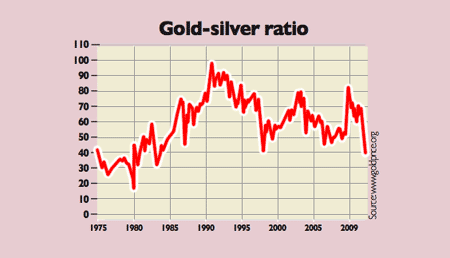
“Silver’s hot,” says Eric Streiner, manager of New York coin dealer Stack’s. All the world’s top mints are selling silver coins at a record pace. Investors are also pouring into silver-backed exchange-traded funds, whose holdings are at unprecedented levels. As the silver market is small – around one tenth the size of the gold market, says Investors Chronicle – it’s no wonder it has rocketed, gaining around 120% over the past year. The price has more than quadrupled since 2008. At around $42 an ounce, it is now not far off its record of just under $50, set on January 1980.
Gold topped out at $835 an ounce in January 1980 and is now close to double that record at about $1,480 an ounce. Over the past year it’s gained around 30%. Silver, having lagged gold during the financial crisis, has made up for lost time. The gold-silver ratio (gold’s price divided by silver’s, showing how many ounces of silver are needed to buy an ounce of gold) has slid to a 28-year low of 36. It has been above 60 since 1985.
Two safe havens…
As precious metals, gold and silver are traditional safe havens and stores of value. So the financial crisis and ongoing concern over the possible break-up of the euro (given the eurozone periphery seems unlikely to get its debts under control) have bolstered both metals in recent years. Money printing by major central banks has fuelled fears of a return of inflation, thus boosting demand for hard assets that can’t be debased by being easilyreproduced. “It is unquestionable that the demand for precious metals derives from the devaluation of the leading currencies, the dollar, the pound and the euro,” says Angelos Damaskos of Sector Investment Managers. Euro jitters are unlikely to disappear soon, and while monetary policy is expected to get tighter with the end of QE2, America’s latest bout of money printing, this shouldn’t derail the precious metals’ bull run.
With higher oil and food prices driving up inflation, inflation-adjusted interest rates remain negative. This means monetary policy is still loose and inflation remains a threat. So investors lose nothing by holding non-interest-bearing gold. “Gold is ultimately dependent upon real rates,” says Jeffrey Currie of Goldman Sachs. “A top in gold prices will only become apparent when the risks of sovereign default are behind us, with a clear andsuccessful exit of the stimulus we’ve seen over the past few years,” he reckons. With countries everywhere beset by debts and central banks keen to keep the recovery going, this seems some way off.
There’s ample scope for demand to rise in China, where rates are also negative, and the population is being encouraged to invest in gold. As demand has already outstripped mined supply for over a decade now, that implies higher gold prices, says MoneyWeek’s Dominic Frisby. China is “the next big driver of the gold bull market”.
… but which is best?
Silver typically magnifies gold’s movements, so should continue to benefit from the gold bull. It’s also an industrial metal, with uses ranging from batteries and solar energy to purification. Industrial demand jumped by 20% last year, says Finanz und Wirtschaft. While the pace may ease as the global economy slows, it looks likely to keep expanding faster than overall industrial production, says Capital Economics, “especially as the majority of applications are relatively insensitive to the price of silver”. Although silver looks expensive in terms of the gold-silver ratio’s recent history, from the Middle Ages until the 1870s the ratio was about 15-1, reflecting the relative abundance of the two metals in the earth’s crust. So taking a long-term view, it’s not that expensive. It also fell below 20 at the peak of the 1980 bull market. But given silver’s tendency to correct violently after sharp run-ups, the safer bet, for now at least, is gold.